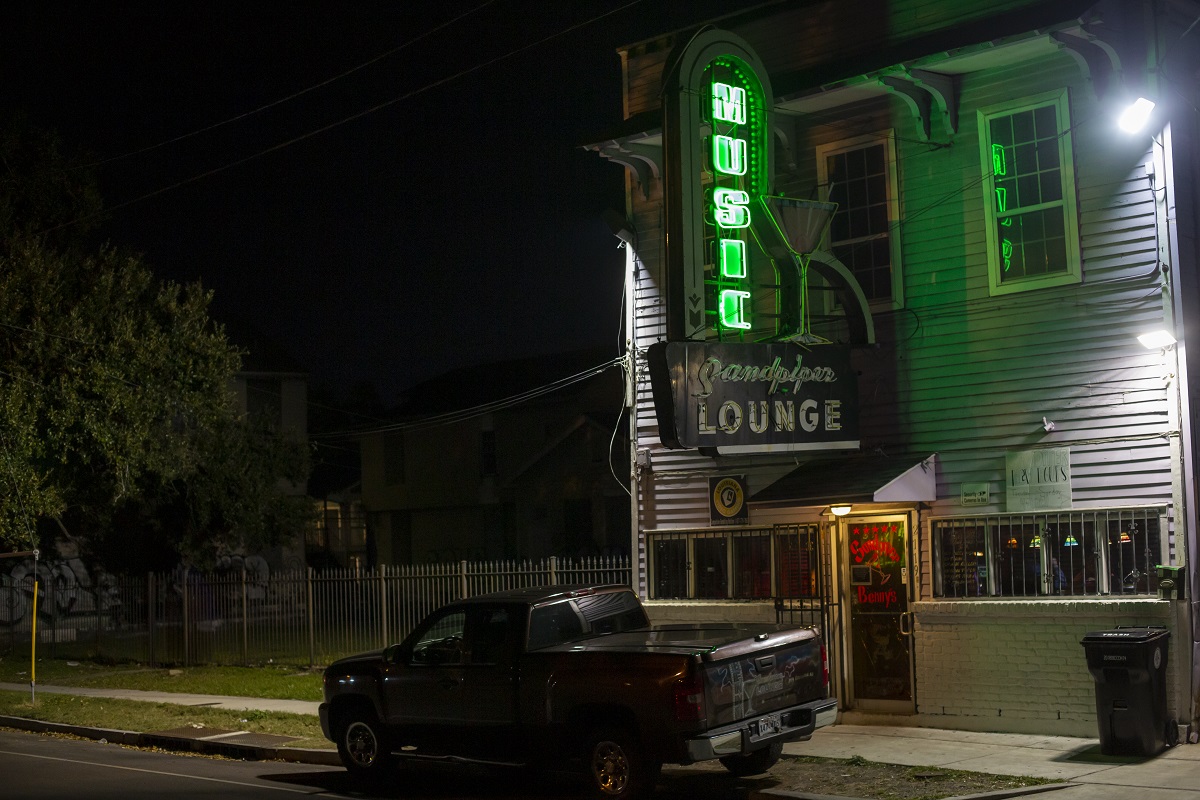The Vanishing Black Bars of New Orleans
The LEH Documentary Photographer of the Year chronicles community spaces under threat
Published: February 28, 2022
Last Updated: March 22, 2023

Baby Let Me Hold Your Hand, Sandpiper Lounge, Louisiana Avenue, 2019.
The shift in these familiar Black spaces made me think of photographer Birney Imes’s Juke Joint. From 1983 to 1989, Imes took his camera around the Mississippi Delta and documented bars in the Black parts of town. He took the viewer inside to experience the cracked walls, scribbled signs, games at the pool table, and lots of Budweiser. Decades ago, Imes knew those juke joints, so omnipresent and region-defining, had a tepid existence. Now, the number of juke joints languishes in the single digits. It made me think of the Black neighborhood bars of New Orleans. I wanted to capture them before they were unrecognizable.
Sometimes at the Other Place, the longest-tenured Black bar on St. Bernard Avenue, a DJ is at the front of the barroom, near the video poker machines, list of rules on the wall, and a flier for the club’s next out-of-town bus trip. Other times, it’s the jukebox and conversations. Outside of the bar on a recent Friday after work, several men held hands, prayed, and returned to their libations.
I met Keith “K. C.” Chaney Sr., an older man and native New Orleanian from Uptown’s Calliope housing projects. K. C. served in the military and has owned a party rental business for forty years. K. C. has visited the Other Place for more than thirty years. He calls these bars the “fabric of New Orleans.” They’re as popular as bodegas in pre-gentrification New York, or coffee shops in Seattle. They are the living rooms of the community. And from his vantage as a regular at the Other Place, K. C. saw this neighborhood shift. Property here was cheap, he said. It’s in a strategic location; folks can walk to the Quarter. It had everything white newcomers wanted. K. C. has watched as three of the six bars on St. Bernard Avenue have turned white. And now, the Other Place is up for sale.
The spaces are the epicenter of Black culture in New Orleans, which is the driving force of New Orleans culture. Black bars and lounges are home to social aid & pleasure clubs, Black masking Indians, and community. Historically they were and remain a respite from the rest of the world and the unfair treatment folk faced in areas outside of their neighborhoods. These bars became a safe space, where patrons could buy affordable drinks, eat, listen to music, and fraternize. If they were in the Mississippi Delta, we’d call them a juke joint, and in South Africa, it’s a shebeen—regardless of what it’s called and where it is, their importance to the culture and community are too often overlooked.
The Black bars and lounges in New Orleans are places where some folk go to watch Saints games or the news. They are places that organize a chartered bus trip to an away Saints game or sometimes to a few cities over, just because. They are places where you could come as you are after work or step out in your finest threads on a weekend. They are places to see Indians practice in the lead-up to Carnival, where they chant, dance, and sing their traditional songs, just without their beautifully beaded suits.

Ya Crown Ain’t Big Enough (Big Chief Bo Dollis Jr. at the Monogram Hunters’ Indian Practice), First and Last Stop Bar, Pauger Street, 2020.
For a while during the pandemic, The Other Place was up for sale. For now, that foreboding real estate sign is gone. But across town, in Central City, the iconic neon sign on the Sandpiper Lounge has been dim for about a year. Social aid and pleasure clubs still stop there on their second lines, but instead of entering they pause outside. The Purple Bar has been sold. Yet places like Sportsman’s Corner Bar & Daiquiris, Kermit’s Mother-in-Law Lounge, First & Last Stop, Bullet’s Sports Bar, and The Other Place are still pouring drinks and serving as repositories for the Black brilliance within these communities.
Kasimu Harris is the 2022 LEH Documentary Photographer of the Year. Vanishing Black Bars & Lounges is on exhibition at the Hilliard Museum of Art on the campus of University Louisiana Lafayette through July 30, 2022.


